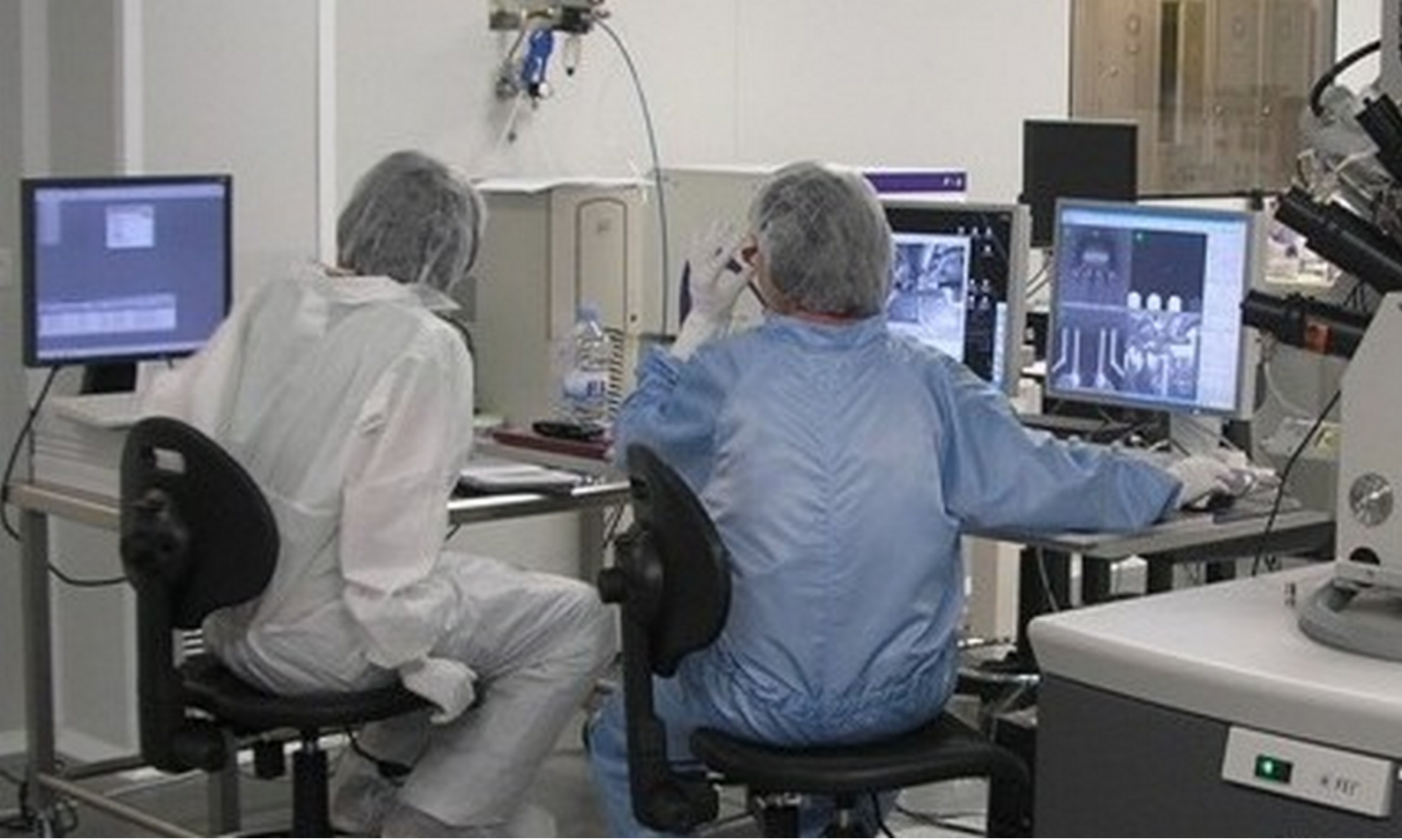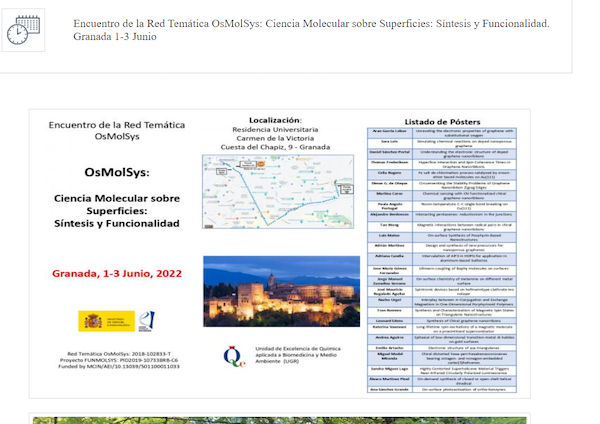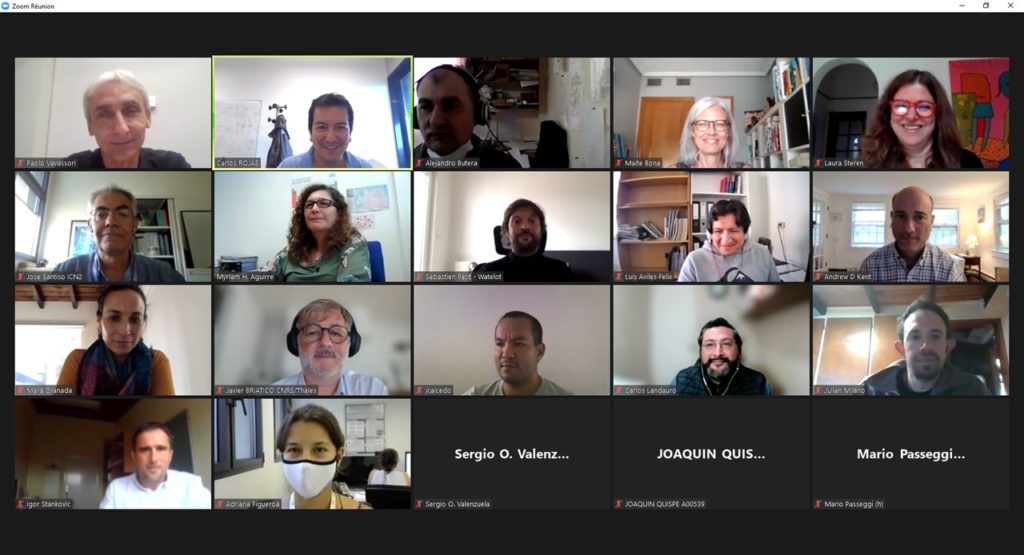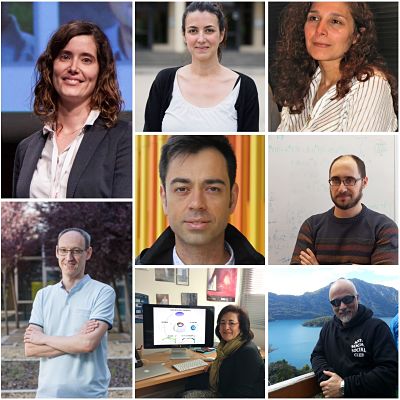FunMolSys Thematic network meeting “CIENCIA MOLECULAR SOBRE SUPERFICIES: SINTESIS Y FUNCIONALIDAD”, funded by the Agencia Estatal de Investigación, reference RED2018-102833-T; University of Granada (Spain), 1st to 3rd June 2022
Magnetism and Magnetic Materials
José Antonio Balseiro School
supported by European Commission ULTIMATE-I project
The José Antonio Balseiro School “Magnetism and Magnetic Materials” will be held from October 10th to November 4th, 2022.
The Balseiro Institute offers a wide range of training courses aimed at students and graduates of physics, engineering, and related subjects. One of these initiatives is the “José Antonio Balseiro School”, which takes place in October and offers scholarships for participation. The scholarships provided consist of financial assistance for travel and accommodation expenses during the stay of those selected. Applications are open until June 3rd.
Students in the last stage of their university careers, who have recently completed their undergraduate studies and are pursuing a postgraduate degree in science or engineering from Argentina and Latin American countries are eligible to apply.
“The aim of the School is for participants to acquire a solid basic knowledge of magnetism and magnetic materials, and at the same time to learn about the most recent phenomena and developments in the field,” said Dr. Mara Granada, a Balseiro Institute graduate, and lecturer, who is a member of the School’s organizing committee.
This activity is organized by the Balseiro Institute’s Secretariat for Outreach and Innovation. Each year it is held on a different theme. The school is organized by teachers, i.e., researchers or active technologists, from the Balseiro Institute, an academic institution dependent on the National Atomic Energy Commission (CNEA) and the National University of Cuyo (UNCuyo).
In 2019, the theme was “Telecommunications”; in 2018, “Applied Physics and Technological Innovation”; and in 2017, “Quantum Fields, Condensed Matter, and Information Theory”. In 2020, the topic “Magnetism and Magnetic Materials” was proposed but had to be suspended due to the pandemic and now the organization has been resumed, according to the organizing committee.
Applicants must have passed at least 75% of their degree course at registration. “Those who were selected in 2020 must register again if they wish to participate this year,” said Granada, who is a CONICET researcher at the Magnetic Resonance Division of the Bariloche Atomic Centre.
According to the Balseiro’s website (www.ib.edu.ar), the application form must be filled in and the following documents must be attached: a CV, a transcript of completed subjects, and a short letter explaining the motivation of the person interested in participating in the School. A letter of recommendation is also required.
The selection process results will be communicated via email on 14 August. Scholarships will be awarded according to each applicant’s academic merits and affinity with this year’s theme.
The School’s program lasts four weeks from Monday to Friday, with theoretical and practical classes and practical work in the laboratories of the Bariloche Atomic Centre. At the end of the stay, a theoretical evaluation will be taken and a poster presentation of the laboratory work will be made. More information at
www.ib.edu.ar/innovacion/escuelas/jab-inicio.html
For further information, please write to the following e-mail address
The sponsors of the October edition of the J. A. Balseiro School organized by the Balseiro Institute in 2022 are the CNEA, the UNCUYO, the Williams Foundation, the J. A. Balseiro Foundation, and the Ultra-Thin Magneto Thermal-SensorIng (ULTIMATE-I) project of the European Commission and the University of Zaragoza.
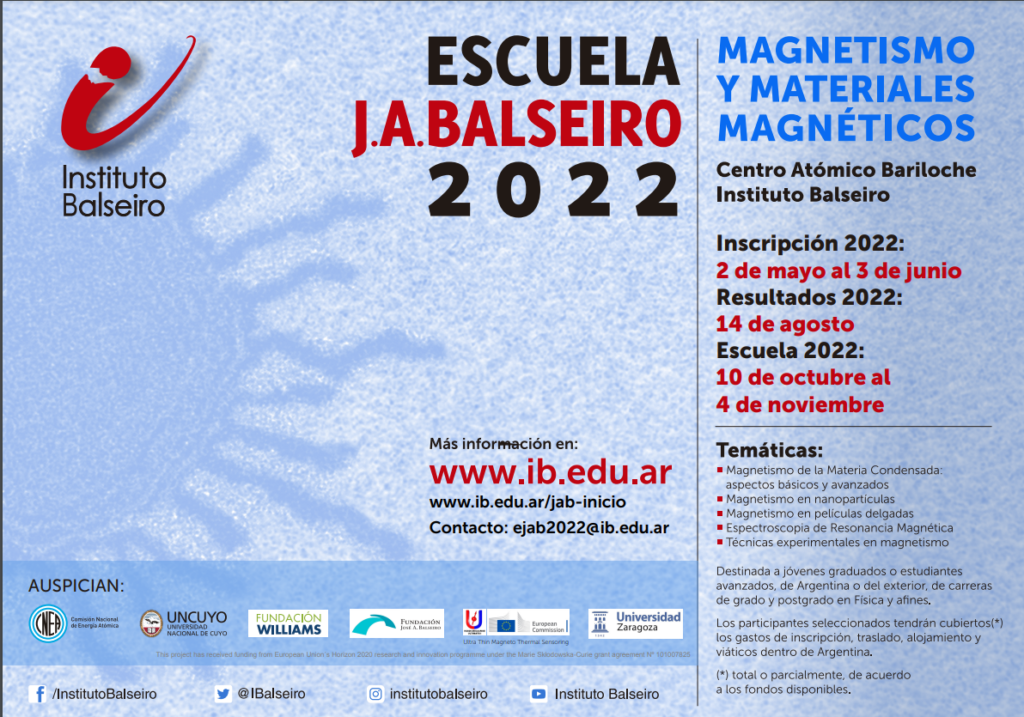
Announcement: International Workshop on Spintronics in San Carlos de Bariloche, Argentina. (6-11 Nov 2022)
International Workshop on Spintronics will be held from November 6th-11th 2022 in San Carlos de Bariloche, Argentina.
This on-site workshop is a follow-up of a similar workshop held in 2019 in Ollantaytambo, Peru and is organized together by the program committee and the local committee of Magnetic Resonance Laboratory at the Balseiro Institute– Centro Atómico Bariloche – Comisión Nacional de Energía Atómica in Bariloche.
The dates have been chosen right after a month-long school organized by the Magnetic Resonance Laboratory at the Balseiro Institute so that students from that school will also be able to attend the workshop. The workshop will include tours in Bariloche and surrounding areas.
The workshop will cover a broad range of topics under the umbrella of nanomagnetism, spintronics and spin-orbitronics ranging from microscopic theory and simulations to recent cutting-edge experiments and applications in nanotechnology. We would be delighted if you could come to Bariloche to present your recent work and to contribute to a new success of the Workshop with scientific quality in a relaxed atmosphere and surrounded by beautiful natural scenery.
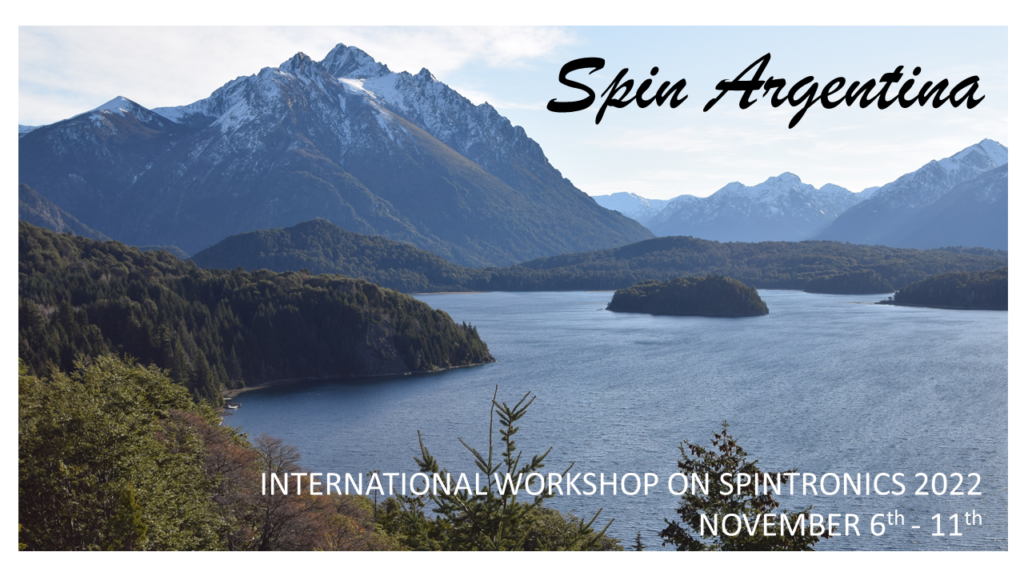
16 Sep – Kick-off meeting
All Beneficiaries and five Partner organisations got together for the online kick-off meeting to get acquainted with each other and discuss research projects, foreseen activities, financial issues, etc.
Introduction to ULTIMATE-I
Magnetic field sensing is a wide and important area of research and technological development in which every new magnetic or spintronic phenomenon discovered there would be an attempt to exploit it for magnetic sensing applications with improved cost-performances. Magnetoresistance is the ratio of the electrical resistance of a material with and without an applied magnetic field. This effect together with anisotropic magnetoresistance has led to a wide range of compact and high-sensitivity magnetic sensors for diverse areas of applications: Geophysics, Astronomics, Archeology, Health Care, and Data Storage. The basic physics of these effects are included in the emergent field of Spintronic, the field of knowledge that deals with the generation, propagation, processing and detection of spin currents. New effects appear with the spin currents as a central property like Spin Hall magnetoresistance (SMR) in hybrid materials ferromagnet/nonmagnetic metal; and other related phenomena: the Spin Hall Effect (SHE) and the Spin Seebeck Effect (SSE) where thermal sensing emerges. If we combine spintronic materials with multiferroic one’s new functionalities can be exploited where electric-field controls spin currents. These effects can be implemented in new strategies to design nanoscale devices. The development of both types of sensors thermal and magnetic sensors shares basic principles of spintronic, then we propose to work in the ULTIMATE-I project with a new hybrid combination of materials in which to better perform the spin to charge conversion, control of spin currents and producing sensor prototypes with outstanding performance. ULTIMATE-I project involves twelve partners with a strong background in spintronics, magnetic and multiferroic materials from the EU and Third Countries, which will dedicate to solve common problems in nanomagnetism, generation and manipulation of spin currents, that affect the detection and sensitivity of sensors.
Europe backs with nearly €4 million creative and innovative research proposals generated at the University of Zaragoza
ULTIMATE-I project deals with a new hybrid combination of materials which better perform the spin-to-charge conversion, control spin currents and produces sensor prototypes with outstanding performance. The financial net contribution of the European Union to the University of Zaragoza is € 473 800 out of a total of € 1 692 800 for six involved beneficiaries.
ULTIMATE-I project involves twelve partners with a strong background in spintronic, magnetic and multiferroic materials from EU and Third Countries, which will dedicate to solving common problems in nanomagnetism, generation and manipulation of spin currents, that affect the detection and sensitivity of sensors.
Press release published on INMA website, 25th Sep. 2020
Press release published on iUNIZAR bulletin, 18th Sep. 2020
Piece of news published on El Periódico de Aragón newspaper, 18th Sep. 2020
Press release published on iUNIZAR bulletin, 17th Sep. 2020
